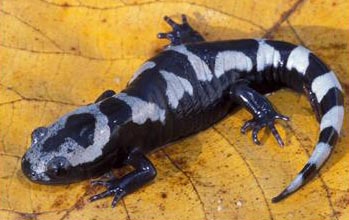See also: North Carolina State Symbols and Official Adoptions main page
Listen to this entry

On June 26, 2013 the Marbled Salamander became the Official State Salamander in North Carolina (Session Laws 2013-189).
Selection as the State Salamander
The North Carolina Herpetological Society led the effort to designate the Marbled Salamander as the Official State Salamander. In hopes of representing the unique amphibian diversity of North Carolina and the Southeast region of the United States, they conducted a poll to determine the amphibians that best represent the state. After over 6,000 total votes in the poll, the Marbled Salamander was chosen along with the Pine Barren TreeFrog. This effort was spearheaded by Rachel Hopkins, a Raleigh teen who has brought awareness to amphibian conservation through her success in getting NC to recognize Save the Frogs Day!.
About the Marbled Salamander
The Marbled Salamander, or Ambystoma Opacum, can be found throughout North Carolina. It is a striking, chunky amphibian, sometimes called the ‘banded’ salamander because of the white bands around its body. Males have silver bands that turn white during breeding to attract a mate. Females are larger, and have silver bands. Every Marbled Salamander has a unique color pattern

The Marbled Salamander is a member of the ‘mole’ salamander family and can grow to be from 9 to 11 centimeters. They like to live in damp woodlands close to ponds or streams. Unlike the rest of the mole salamander family, the Marbled Salamander does not breed in water. The female instead will lay from 50 to 100 eggs under leaves in dried up pools or ponds. The eggs hatch when rains come and the ponds refill.
Baby salamanders, called larvae, hatch in the water and grow very quickly because they are constantly eating plankton. Larvae will stay in the water for two to nine months, and are considered adults 15 months after leaving the water. They usually live for three to four years.
Adult Salamanders spend most of their time in burrows underground or in leaf litter. They eat large amounts of food, and love to snack on small worms, insects, slugs, and snails. Predators of the Marbled Salamander include snakes, owls, raccoons, skunks, shrews, and weasels. To defend itself, the Marbled Salamander emits poison from glands on its tail which discourages others from eating it.
The Marbled Salamander is identified by the North Carolina Wildlife Commission's 2005 North Carolina Wildlife Action Plan as priority species for population monitoring and conservation in North Carolina.